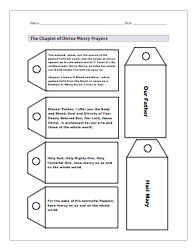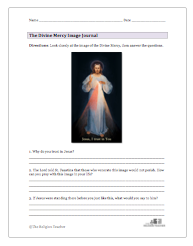Give your students a great spiritual gift this year. Introduce them to the devotion to Divine Mercy with this lesson and activities.
The Divine Mercy devotion originated with a polish nun, St. Faustian Kowalski, who had visits from Christ in the 1930s. She wrote down her conversations with Jesus in a diary, which included a number of suggestions for devotion to Divine Mercy. These revelations had a particular impact on Pope St. John Paul II, who brought the devotions into worldwide adoption including the Chaplet of Divine Mercy, the Divine Mercy Image, and Divine Mercy Sunday (the first Sunday after Easter).
In this lesson plan, you are invited to introduce students to the devotion of Divine Mercy in general, but specifically to teach the students the Chaplet of Divine Mercy, which is to be practiced using a rosary.
The printable worksheets to go along with this lesson are available to The Religion Teacher members, but they can also be downloaded by entering your email here:
Divine Mercy Lesson Objectives
- SWBAT pray the Chaplet of Divine Mercy.
- SWBAT list the different ways we can practice a devotion to Divine Mercy.
- SWBAT recognize their own need for God’s Divine Mercy.
Divine Mercy Lesson Activities
1. Present: An Introduction to Divine Mercy
To introduce students to the Divine Mercy devotion, do some background reading at some of these websites:
You can simply explain about the devotion to the children yourself, or have students research the devotion and answer a few important questions:
- With whom did devotion to Divine Mercy originate? How did it start?
- What is the main message of Divine Mercy?
- Describe the Divine Mercy image.
- How do you pray the Chaplet of Divine Mercy?
- When is the Divine Mercy Novena typically started?
- Why is 3 o’clock so important for practicing a devotion to Divine Mercy?
- When do we celebrate a specific devotion to Divine Mercy?
Alternative resource for members: Introduction to Divine Mercy Devotion Video (login or join)
2. Practice: Divine Mercy Prayer
This may seem backwards, but the best way to introduce students to the Divine Mercy devotion is to start by praying. After experiencing the Chaplet of Divine Mercy, you can help students unpack the meaning of the words that they prayed.
Immediately introduce them to the chaplet and the image. Don’t wait. Let the Lord work through the devotional practice, then come back and give the students the opportunity to understand what they said and did more deeply.
Prepare the students to pray the Chaplet of Divine Mercy while meditating on the Divine Mercy image. Provide a print out of the prayers (here, here, or here) and rosaries to each student. Pull up the Divine Mercy image on the projector screen or TV in your classroom or, even better, bring in your own copy or the parish’s copy of the image to your class. You can even give out Divine Mercy prayer cards if you have them.
Then, pray a Chaplet of Divine Mercy
If the devotion is new to you, use one of these videos on YouTube to lead you in the prayer:
3. Practice: Divine Mercy Activities
Have students do one or all of these Divine Mercy activities at their desk or set up centers/stations around the room and rotate groups of students between each station in 5-10 minute intervals.
Download the handouts for these activities here:
Activity #1: Chaplet of Divine Mercy Prayer Tags

Print out the handout with the prayers of the Chaplet of Divine Mercy. Have students cut out the prayers and the circles with a small slit to open up the circle. Have the students attach each prayer to the part of the rosary when we pray each prayer.
Activity #2: Divine Mercy Image Journal

Print out the handout with a copy of the Divine Mercy image. Below the image are a set of reflection questions to help the students meditate on the image. Have the students reflect on their lives as they examine the image and offer a silent prayer in conversation with the Lord.
Activity #3: Divine Mercy Examination of Conscience

What better way to experience God’s Divine Mercy than reflecting on the areas of our lives in which we need God’s mercy the most? Students can use this examination of conscience in preparation for the Sacrament of Penance or they can use it to prepare their hearts to pray the Chaplet of Divine Mercy.
4. Proof: Divine Mercy Assessment
To check their understanding of everything they have learned about the devotion, have students create a mind map of Divine Mercy. Write the words “Divine Mercy” in the center, then create bubbles around the outside with the different ways we can practice devotion to Divine Mercy. Outside of those bubbles, students can write details about other things they have learned about the chaplet, image, novena, hour, day, and history of the devotion.
You can find a Mind Map template here among many other graphic organizers.


